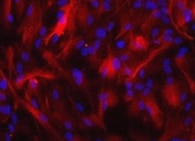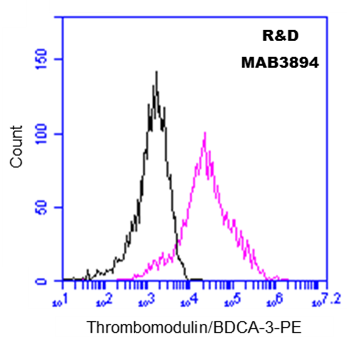Mouse Thrombomodulin/BDCA-3 Antibody Summary
Leu17-Ser517
Accession # P15306
Applications
under non-reducing conditions only
Please Note: Optimal dilutions should be determined by each laboratory for each application. General Protocols are available in the Technical Information section on our website.
Scientific Data
 View Larger
View Larger
Thrombomodulin/BDCA-3 in bEnd.3 Mouse Cell Line. Thrombomodulin/BDCA-3 was detected in immersion fixed bEnd.3 mouse endothelioma cell line using Mouse Thrombomodulin/BDCA-3 Monoclonal Antibody (Catalog # MAB3894) at 10 µg/mL for 3 hours at room temperature. Cells were stained using the NorthernLights™ 557-conjugated Anti-Rat IgG Secondary Antibody (red; Catalog # NL013) and counterstained with DAPI (blue). View our protocol for Fluorescent ICC Staining of Cells on Coverslips.
 View Larger
View Larger
Thrombomodulin/BDCA-3 in Mouse Heart. Thrombomodulin/BDCA-3 was detected in perfusion fixed frozen sections of mouse heart using 25 µg/mL Mouse Thrombomodulin/BDCA-3 Monoclonal Antibody (Catalog # MAB3894) overnight at 4 °C. Tissue was stained with the Anti-Rat HRP-DAB Cell & Tissue Staining Kit (brown; Catalog # CTS017) and counterstained with hematoxylin (blue). View our protocol for Chromogenic IHC Staining of Paraffin-embedded Tissue Sections.
 View Larger
View Larger
Detection of Thrombomodulin/BDCA‑3 in bEnd.3 Mouse Cell Line by Flow Cytometry. bEnd.3 mouse endothelioma cell line was stained with Mouse Thrombomodulin/BDCA‑3 Monoclonal Antibody (Catalog # MAB3894, filled histogram) or isotype control antibody (Catalog # MAB0061, open histogram), followed by Phycoerythrin-conjugated Anti-Rat IgG F(ab')2Secondary Antibody (Catalog # F0105B).
Reconstitution Calculator
Preparation and Storage
- 12 months from date of receipt, -20 to -70 °C as supplied.
- 1 month, 2 to 8 °C under sterile conditions after reconstitution.
- 6 months, -20 to -70 °C under sterile conditions after reconstitution.
Background: Thrombomodulin/BDCA-3
Encoded by the THBD gene, Thrombomodulin is also known as CD141 antigen. The deduced amino acid sequence of mouse THBD predicts a signal peptide (aa 1 to 16) and a mature chain (aa 17 to 577) that consists of the following domains: C-type lectin (aa 31 to 167), EGF-like (aa 240 to 280, aa 283 to 323, aa 324 to 362, aa 364 to 404, aa 405 to 439, and aa 440 to 480), transmembrane (aa 518 to 541) and cytoplasmic (aa 542 to 577) (1). The R&D Systems rmTHBD consists of aa 17 to 517, corresponding to the extracellular portion of the type I membrane protein. Predominantly synthesized by vascular endothelial cells, THBD inhibits coagulation and fibrinolysis (2‑4). It functions as a cell surface receptor and an essential cofactor for active thrombin, which in turn activates protein C and thrombin-activatable fibrinolysis inhibitor (TAFI), also known as carboxypeptidase B2 (CPB2). Activated protein C (APC), facilitated by protein S, degrades coagulation factors Va and VIIIa, which are required for thrombin activation. Activated CPB2 cleaves basic C-terminal amino acid residues of its substrates, including fibrin, preventing the conversion of plasminogen to plasmin. In addition, THBD gene polymorphisims are associated with human disease and THBD plays a role in thrombosis, stroke, arteriosclerosis, and cancer (5). For example, increased serum levels of THBD, due to protease cleavage, have been associated with smoking, cardiac surgery, atherosclerosis, liver cirrhosis, diabetes mellitus, cerebral and myocardial infarction, and multiple sclerosis (6).
- Dittman, W.A. and P.W. Majerus (1989) Nucleic Acids Res. 17:802.
- Van de Wouwer, M. et al. (2004) Arterioscler. Thromb. Vasc. 24:1374.
- Wu, K.K. et al. (2000) Ann Med. 32:73.
- Li, Y.H. et al. (2006) Cardiovasc. Hematol. Agents Med. Chem. 4:183.
- Weiler, H. and B.H. Isermann (2003) J. Thromb. Haemost. 1:1515.
- Califano, F. et al. (2000) Eur. Rev. Med. Pharmacol. Sci. 4:59.
Product Datasheets
Citations for Mouse Thrombomodulin/BDCA-3 Antibody
R&D Systems personnel manually curate a database that contains references using R&D Systems products. The data collected includes not only links to publications in PubMed, but also provides information about sample types, species, and experimental conditions.
5
Citations: Showing 1 - 5
Filter your results:
Filter by:
-
SARS-CoV-2 spike protein induces lung endothelial cell dysfunction and thrombo-inflammation depending on the C3a/C3a receptor signalling
Authors: Perico, L;Morigi, M;Pezzotta, A;Locatelli, M;Imberti, B;Corna, D;Cerullo, D;Benigni, A;Remuzzi, G;
Scientific reports
Species: Transgenic Mouse
Sample Types: Whole Tissue
Applications: IHC -
Protective Role of Activated Protein C against Viral Mimetic Poly(I:C)-Induced Inflammation
Authors: Xiaofeng Cai, Sumith R. Panicker, Indranil Biswas, Hemant Giri, Alireza R. Rezaie
Thrombosis and Haemostasis
-
Heme Drives Susceptibility of Glomerular Endothelium to Complement Overactivation Due to Inefficient Upregulation of Heme Oxygenase-1
Authors: Olivia May, Nicolas S. Merle, Anne Grunenwald, Viviane Gnemmi, Juliette Leon, Cloé Payet et al.
Frontiers in Immunology
-
Activated TAFI Promotes the Development of Chronic Thromboembolic Pulmonary Hypertension: A Possible Novel Therapeutic Target
Authors: T Satoh, K Satoh, N Yaoita, N Kikuchi, J Omura, R Kurosawa, K Numano, E Al-Mamun, MA Siddique, S Sunamura, M Nogi, K Suzuki, S Miyata, J Morser, H Shimokawa
Circ. Res, 2017-03-13;0(0):.
Species: Mouse
Sample Types: Whole Tissue
Applications: IHC-P -
Heme triggers TLR4 signaling leading to endothelial cell activation and vaso-occlusion in murine sickle cell disease.
Authors: Belcher J, Chen C, Nguyen J, Milbauer L, Abdulla F, Alayash A, Smith A, Nath K, Hebbel R, Vercellotti G
Blood, 2013-11-25;123(3):377-90.
Species: Mouse
Sample Types: In Vivo
Applications: Bioassay
FAQs
No product specific FAQs exist for this product, however you may
View all Antibody FAQsReviews for Mouse Thrombomodulin/BDCA-3 Antibody
Average Rating: 5 (Based on 2 Reviews)
Have you used Mouse Thrombomodulin/BDCA-3 Antibody?
Submit a review and receive an Amazon gift card.
$25/€18/£15/$25CAN/¥75 Yuan/¥2500 Yen for a review with an image
$10/€7/£6/$10 CAD/¥70 Yuan/¥1110 Yen for a review without an image
Filter by:
106 Mouse PBMCs were incubated with 2.5 ug of Rat anti-Mouse Thrombomodulin/BDCA-3 antibody (pink) or Isotype Control IgG (black), followed by PE-conjugated Anti-Rat secondary antibody.





